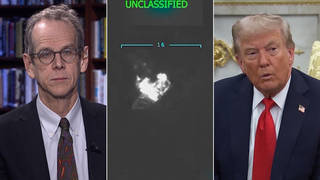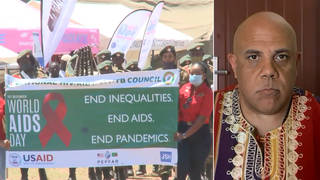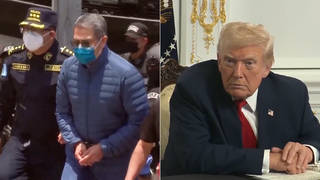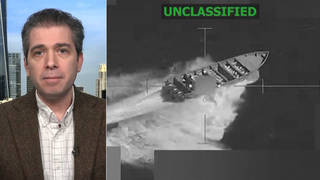
Guests
- Ernesto Arcecorrespondent for the Pacifica Radio station KPFK in Los Angeles. He was shot with a police rubber bullet at the May Day protest.
- Gerardo Gomezcounselor and homeless rights activist who was shot twice at the protest.
Links
The Los Angeles Police Department is coming under increasing criticism for violently crushing a largely peaceful immigrants rights march on Tuesday. Police dressed in riot gear fired 240 rounds of rubber and foam bullets as well as tear gas. Officers were seen on video clubbing protesters and journalists with batons. Overall, 10 people, including several journalists, were taken to hospitals after being injured. [includes rush transcript]
Transcript
JUAN GONZALEZ: The Los Angeles Police Department is coming under increasing criticism for violently crushing a largely peaceful immigrant right march on Tuesday. Police with riot guns fired 240 rounds, shot tear gas and clubbed protesters and journalists gathered in MacArthur Park. At least 10 people were injured, including several journalists.
Pedro Sevcec was broadcasting live for the Spanish-language television network Telemundo when police knocked over his monitors and lights and hit his staff with batons. Sevcec told the Los Angeles Times a police officer grabbed one of his cameras and threw it more than 15 feet to the ground. He said police pointed a riot gun at his face, hit him with a baton and forced him out of the park.
Patricia Nazario of the public radio station KPCC was also injured. On Wednesday, Nazario described to listeners what happened to her.
PATRICIA NAZARIO: The cop jammed me in my ribs with his billy club, and so I turned around square, looking at him. I had my press pass on. I had my mic flag in my hand, my notepad and my pen. And I said, “Why did you hit me? I’m a reporter.” And he said, “Move!” And I said, “I am moving! Why did you hit me? I’m a reporter.” And he hit me again, harder that time, and I fell.
JUAN GONZALEZ: Others assaulted included four employees of KVEA-TV Channel 52 and a reporter for the public radio station KPCC hit by a police baton. Christina Gonzalez, a reporter for the Fox affiliate KTTV-TV Channel 11, suffered a bruised shoulder after she was shoved to the ground. Her camera operator suffered a broken wrist. The incident was caught on tape.
KTTV NEWS: Police in riot gear moved into MacArthur Park after some protesters started throwing rocks and plastic bottles at officers. But this time it was impossible for the news media to be impartial observers.
CHRISTINA GONZALEZ: I am helping her move!
LAPD OFFICER: Move her back away from the [inaudible], or you’re under arrest!
CHRISTINA GONZALEZ: You can’t do that! You cannot do that, and you know that!
LAPD OFFICER: This way! Go this way! Go this way!
KTTV NEWS: It didn’t stop with pushing and shoving. Police officers fired rubber bullets. Protesters say they had no warning that officers were moving in.
CHRISTINA GONZALEZ: We are talking about an order to disperse, which I never heard. Neither did people getting hit by rubber bullets. That man was standing next to a colleague’s network live shot, which caught this.
KTTV NEWS: A photographer was trying to capture all of the action when he was targeted by police. He’s knocked over, then kicked. The officer even grabs and throws his camera. As our crew tries to move to safety, the police officer hits cameraperson Patti Ballaz.
CHRISTINA GONZALEZ: Here is a perspective from our colleagues at Univision. You see us on the right side of the screen. Patti goes down. I am trying to protect her, but they don’t stop, even though I’m telling them we are trying to get to our truck a few feet away.
AMY GOODMAN: A report by Fox affiliate KTTV Channel 11. The LAPD says it gave orders to disperse, but several journalists and protesters have disputed the account. The order was made only in English, not even near the main crowd. L.A. Police Chief William Bratton admitted the actions taken by the police were inappropriate. He said, “I was disturbed at what I saw.” The LAPD has launched a pair of investigations. Several news groups say they’re considering legal action.
We go now to Los Angeles to two guests. Ernesto Arce is a correspondent for Pacifica Radio station KPFK in Los Angeles. He was shot with a police rubber bullet at the May Day protest. Also on the line, Gerardo Gomez, counselor and homeless rights activist who was shot twice at the protest.
Ernesto Arce, let’s begin with you. Where were you? What did you see?
ERNESTO ARCE: Good morning, Amy. I was at the southeast corner of the park, MacArthur Park, which I believe was at Seventh and Alvarado. I was trying to get a sense of what was happening. I noticed that there was a lot of commotion at that end of the park, and there was a lot of people were running and fleeing. So I wanted to see what it was that was happening, and I also wanted to get onto the Metrolink to get home. But, of course, I wasn’t able to do that, since there was a heavy police presence on Alvarado Street.
It was then that I noticed that, you know, police in — I guess it was two different kinds of cops. There was the regular cops, and then there was the SWAT team, who had come in, you know, very shielded attire. They also were holding what looked like rifles. They began to push people back from the very southeast corner of the park into the park. They were at first using batons. But I noticed that they began to shoot. You know, I wasn’t sure what type of — whether it was tear gas or whether they were actual real bullets or rubber pellets. But many people were getting hit. It was at that time that people began to just, you know, flee towards the north of the park. There was a lot of commotion. There was a lot of confusion.
Hundreds of families were still there. Actually, at this end of the park, the main rally, which was attended by approximately 5,000 to 10,000 people, organized by the MIWON, Multiethnic [Immigrant] Workers coalition, was still going on at this time. It hadn’t been broken up, so there was still several hundred families even on the south side of this park. A lot of people were running, screaming. There were families. There were children. There’s a large transient population that lives at MacArthur Park, a lot of homeless individuals, handicapped individuals and, of course, streetcar vendors that, you know, sell different fares, whether ice cream or hot dogs, and they were unable to get out on time.
And the police were relentless. They were merciless. They would hit anyone in their path. They would shoot at anyone. Actually, a lot of people were shot on the back, including myself. And, yeah, it was just — it was total chaos and, again, another example of Los Angeles Police Department brutality.
JUAN GONZALEZ: Ernesto, from what you were able to tell, what touched off this disproportionate response, given the fact that, for instance, last year half a million people marched in Los Angeles in the biggest protest in that state’s history, and now with this much smaller crowd the police reacted in this way?
ERNESTO ARCE: Well, it seems like they were trying to clear the Alvarado Street for ongoing traffic, and there was a gathering, a large gathering, a circle of people that were gathered around Aztec danzantes, or pre-Columbian Mexican dancers, and they were holding a ceremony. And police on motorcade decided to forcibly break that up, and they drove their motorcycles through this crowd. They were followed by police on bike and followed by more police on foot. The police on bike and the police on foot forcibly removed the people.
I think there was some resistance, because I think, you know, the Aztec dancers weren’t able to pick up their ceremonial possessions and some of the things that they had with them — drums, etc. — and they weren’t able to move quickly enough. I know several people were pushed over onto the ground by the police, and they weren’t able to make it, you know, onto the sidewalk, as the police were demanding. So I think there was definitely that original skirmish, which happened approximately 30 minutes after the march concluded or arrived at MacArthur Park at approximately 5:30.
AMY GOODMAN: In addition to Ernesto Arce, correspondent with KPFK, Pacifica Radio station in Los Angeles, who himself was shot with a rubber bullet, we’re joined by Gerardo Gomez, a counselor and homeless rights activist in Los Angeles, shot twice with rubber bullets by the LAPD. Gerardo, describe exactly what happened to you, where you were, what point of the protest, and how you got shot.
GERARDO GOMEZ: I was there around 5:40, close to the corner of Seventh and Alvarado, and I was just a spectator just on the sidewalk by the park, when about maybe 15 minutes later — I don’t know — we see cops like pushing the people out of the park and throwing tear gas and rubber bullets.
And the first time I got shot, I would say I was probably maybe 400 feet away, and I got hit and then I started panicking and started running. I went to the other side of the park, which was maybe on the — it’s probably the east side of Seventh and Alvarado, like on the soccer side. That’s when like — those are the images that’s been showing on TV, where like it’s on a soccer field, and the cops just started like decided like just harassing the people and not giving any orders and then shooting at people.
The second time that I got shot, I was very close to the Spanish cameraman who got hit with a bullet, and because he wasn’t able to get up, he got hit with a baton. So the second time I got hit, I was like 50 feet away. And I rolled down, and I was trying to — I was in pain, but if I didn’t get up on time, I was going to get hit again.
And I want to remind you that what they did yesterday is totally inappropriate, and I know that there had been mentioned reports that there was like — they’re trying to blame it on the young anarchists, but in reality, the cops got caught and the fact that they got caught and that it’s in the videos, they’re trying to find someone to blame it for. So it’s easy for them to say, “Oh, let’s blame it on young anarchists,” and that’s not right. They didn’t give no warnings. They didn’t give nothing.
And what the people in L.A., we’ve been asking — we’re asking the resignation of Chief Bratton, because what he’s been doing, it’s the same thing that he did in New York with the Million Youth March on September 5, 1998. And it was the exact same scenario, and we saw what he did with the homeless people in Times Square. That’s exactly what he’s doing here in Skid Row, trying to press the homeless people away. And then with his police brutality, the Suzie Pena case, the Devin Brown case, all these actions are inappropriate. And for him to get another five-year term, that’s inappropriate.
But we’re not only just asking for the resignation of Chief Bratton, but we’re asking for the city of L.A. to change the way the system works, the policing system works. And we’re asking for a definite [inaudible]. In the state of Guerrero, what they do, the cops, it’s the committee who runs the cops. They realized that the police system is so corrupt, so it’s a voluntary program. So it’s the community themselves, they’re controlling their own like neighborhood, and when a family goes out to patrol the streets, the community helps the family by providing them with beans and rice. And that’s what we’re trying to let the city of L.A. know, that we’re not just asking for the resignation of Chief Bratton, but we’re asking for them to change the policing system, because what they did on May Day, yeah, they instigated fear on us, but what they did, they reassured to us that we cannot trust the police.
AMY GOODMAN: Ernesto Arce, let me ask you a question. The Police Commissioner Bratton, formerly here in New York the police commissioner — the mayor, Villaraigosa, he was in El Salvador during the May Day protest. Where is he now, and what has he said?
ERNESTO ARCE: From what I heard, the mayor was on a seven- or eight-day tour of Latin America — actually just two countries: Mexico and El Salvador. He was meeting with Mexican President Felipe Calderon, as well as Salvadoran President Tony Saca, and they’re mostly there to mention — or mostly there to talk about business deals, as well as what they call the transnational gang threat, which is essentially las maras, or the gangs that have crossed from one nation to another. I think his original response was that he thought it was unfortunate, and he’s calling for a full transparent investigation, but he has completely supported Chief Bratton in the past, and he did offer words of encouragement, and he said that, you know, everything was being done to investigate the situation and that he would be returning pretty soon.
JUAN GONZALEZ: And, Ernesto, for those folks who are not familiar with Los Angeles, could you talk about the importance of MacArthur Park? This has been the site over decades of many protests in the Latino community, hasn’t it?
ERNESTO ARCE: That’s right. It’s actually named after General MacArthur, who I suppose was a war hero during the Korean War. It’s similar to New York’s Central Park. It’s probably the largest park in Los Angeles County, or rather within Los Angeles city limits. It’s — again, I’m not exactly sure what the size is, but it’s a really large park. It’s in the Westlake neighborhood, which has since maybe the late or mid '80s has been home to predominantly Central American and Latino immigrants. It's in a very impoverished and, you know, neglected, underserved neighborhood. And there has been many protests at MacArthur Park. I know some of the Filipino World War II veterans held protests there every year, and, of course, many immigrant rights protests are held there at MacArthur Park. Last year, one of the two main rallies on May Day was organized there at MacArthur Park. And, yeah, I mean, it’s a site for a lot of different activities.
AMY GOODMAN: Ernesto, we only have a second, but what about those who want to talk about what happened to them, but this was an immigrants’ rights protest, afraid perhaps of being identified, of being targeted for being undocumented?
ERNESTO ARCE: Yeah, and I think that’s the problem. You know, I think —- we held a special program here in Los Angeles yesterday, and a lot of people were saying -—
AMY GOODMAN: Five seconds.
ERNESTO ARCE: — that they were terrified to move forward and to actually, you know, file reports against the police.
AMY GOODMAN: Ernesto Arce, I want to thank you very much for being with us, as well as Gerardo Gomez.












Media Options